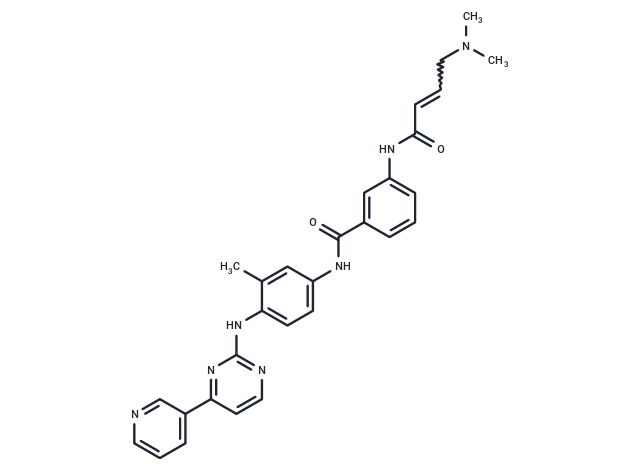Shopping Cart
- Remove All
 Your shopping cart is currently empty
Your shopping cart is currently empty

JNK-IN-8 (JNK Inhibitor XVI) is an irreversible JNK1/2/4 inhibitor (IC50: 4.7/18.7/1 nM) with over 10-fold selectivity compared to MNK2 and Fms, and no inhibition of Met, c-Kit, or PDGFRβ in the A375 cell line.

| Pack Size | Price | Availability | Quantity |
|---|---|---|---|
| 2 mg | $39 | In Stock | |
| 5 mg | $70 | In Stock | |
| 10 mg | $122 | In Stock | |
| 25 mg | $218 | In Stock | |
| 50 mg | $363 | In Stock | |
| 100 mg | $536 | In Stock | |
| 200 mg | $761 | In Stock | |
| 1 mL x 10 mM (in DMSO) | $79 | In Stock |
| Description | JNK-IN-8 (JNK Inhibitor XVI) is an irreversible JNK1/2/4 inhibitor (IC50: 4.7/18.7/1 nM) with over 10-fold selectivity compared to MNK2 and Fms, and no inhibition of Met, c-Kit, or PDGFRβ in the A375 cell line. |
| Targets&IC50 | JNK1:4.7 nM, JNK2:18.7 nM, JNK:1 nM |
| In vivo | JNK-IN-8 (10 mM) effectively inhibits the phosphorylation of c-Jun stimulated by IL-1β in IL-1R cells. It displays significant selectivity for the 1,4-bis(phenylamino) and 1,3-aminobenzoic acid structural regions compared to imatinib, covalently binding to the Cys154 target via an N,N-dimethylbutenamide linkage. JNK-IN-8 inhibits the phosphorylation of c-Jun in HeLa (EC50: 486 nM) and A375 (EC50: 338 nM) cells. Its binding with PIK3C3, IRAK1, PIP5K3, and PIP4K2C significantly enhances selectivity and elimination rates. JNK-IN-8 inhibits JNK2 through Cys116. |
| Kinase Assay | A375 cells are pre-treated with 1 μM JNK-IN-8 for the indicated amounts of time. Remove the medium and wash 3 times with PBS. Resuspend the cell pellet with 1 mL Lysis Buffer (1% NP-40, 1% CHAPS, 25 mM Tris, 150 mM NaCl, Phosphatase Inhibitor Cocktail, and Protease Inhibitor Cocktail). Rotate end-to-end for 30 min at 4°C. Lysates are cleared by centrifugation at 14000 rpm for 15 min in the Eppendorf. The cleared lysates gel filtered into Kinase Buffer (0.1% NP-40, 20 mM HEPES, 150 mM NaCl, Phosphatase Inhibitor Cocktail, Protease Inhibitor Cocktail) using Bio-Rad 10DG colums. The total protein concentration of the gel-filtered lysate should be around 5-15 mg/mL. Cell lysate is labeled with the probe from ActivX at 5 μM for 1 hour. Samples are reduced with DTT, and cysteines are blocked with iodoacetamide and gel filtered to remove excess reagents and exchange the buffer. Add 1 volume of 2X Binding Buffer (2% Triton-100, 1% NP-40, 2 mM EDTA, 2X PBS) and 50 μL streptavidin bead slurry and rotate end-to-end for 2 hours, centrifuge at 7000 rpm for 2 min. Wash 3 times with 1X Binding Buffer and 3 times with PBS. Add 30 μL 1X sample buffer to beads, heat samples at 95°C for 10 min. Run samples on an SDS-PAGE gel at 110V. After transferred, the membrane is immunoblotted with JNK antibody[1]. |
| Cell Research | JNK-IN-8 is dissolved in DMSO and stored, and then diluted with appropriate media before use[1]. HEK-293 cells stably expressing Interleukin Receptor 1 (HEK293-IL1R) are cultured in Dulbecco's Modified Eagle's medium (DMEM) supplemented with 10% FBS, 2 mM glutamine and 1×antimycotic/antibiotic solution. Cells are serum starved for 18 h before incubation with DMSO or JNK-IN-8, stimulated with 2 μM Anisomycin for 1h and lysates are clarified by centrifugation for 10 min at 16000 g and 4°C[1]. |
| Alias | JNK Inhibitor XVI |
| Molecular Weight | 507.59 |
| Formula | C29H29N7O2 |
| Cas No. | 1410880-22-6 |
| Smiles | CN(C)CC=CC(=O)Nc1cccc(c1)C(=O)Nc1ccc(Nc2nccc(n2)-c2cccnc2)c(C)c1 |
| Relative Density. | 1.283 g/cm3 (Predicted) |
| Storage | Powder: -20°C for 3 years | In solvent: -80°C for 1 year | Shipping with blue ice. | |||||||||||||||||||||||||||||||||||
| Solubility Information | DMSO: 55 mg/mL (108.36 mM), Sonication is recommended. H2O: < 1 mg/mL (insoluble or slightly soluble) Ethanol: < 1 mg/mL (insoluble or slightly soluble) | |||||||||||||||||||||||||||||||||||
Solution Preparation Table | ||||||||||||||||||||||||||||||||||||
DMSO
| ||||||||||||||||||||||||||||||||||||

Copyright © 2015-2025 TargetMol Chemicals Inc. All Rights Reserved.